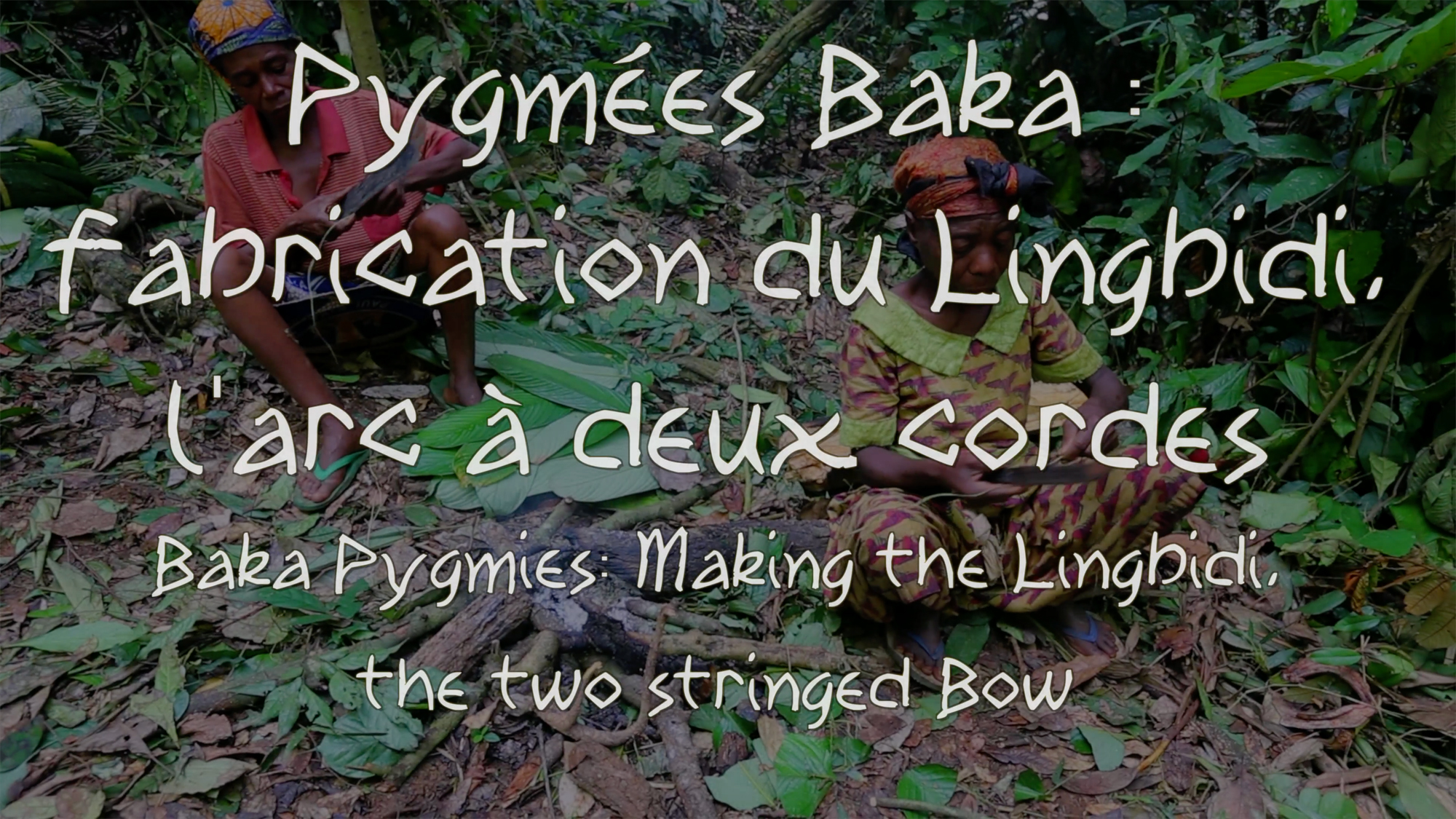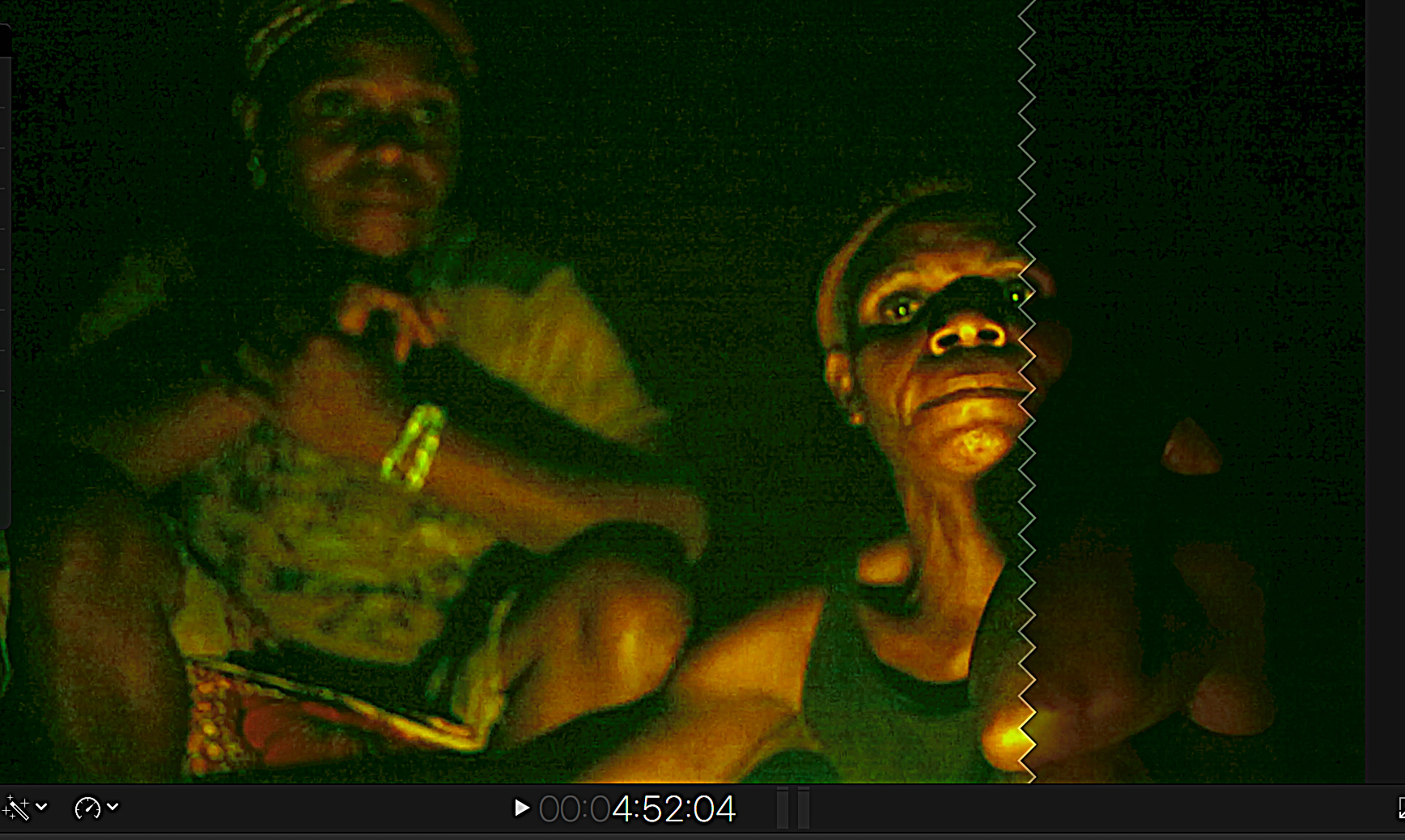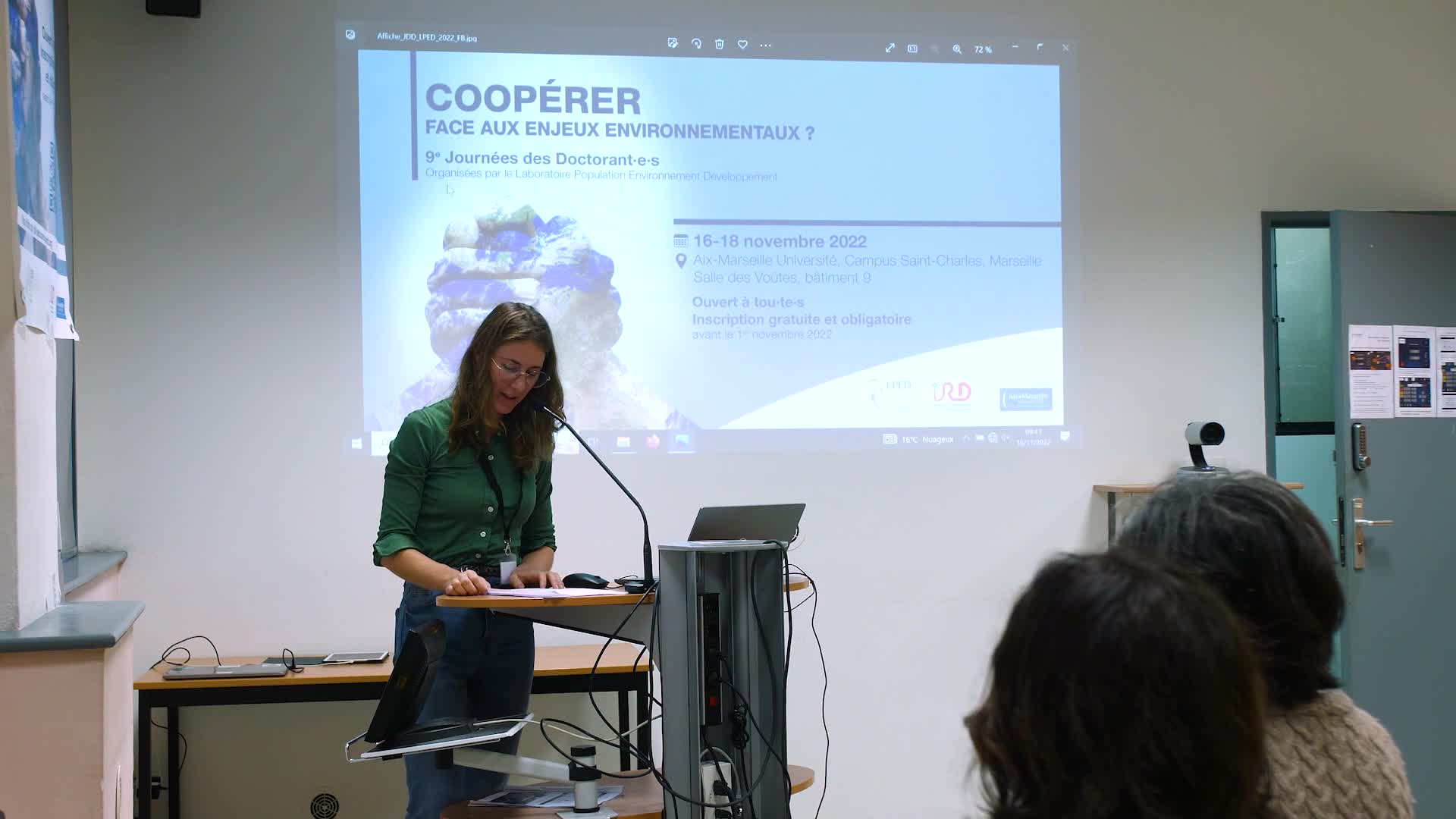Notice
Forest camp cooking : a meal of porcupine. Baka chronicles. Messok district, East Cameroon, June 2013
- document 1 document 2 document 3
- niveau 1 niveau 2 niveau 3
Descriptif
Camera, sound, editing : Romain Duda
The brush-tailed porcupine (Atherurus africanus) is one of the most appreciated and hunted game species in Central Africa. Abundant near the villages, this porcupine is hunted by smoking its burrow or hideout, or using snare traps made with metal wire.
That day, a porcupine is brought back to the camp of Zumlo (place of punctual or seasonal forest life of the lineage of Sanga Timothée), located in two hours of walk of the village. The catch of this game, so small is it, delighted the whole camp because everyone will benefit from a part of meat. If this game had been brought back to the village (the space along dirt roads, which brings together several lineages), it would inevitably have given rise to jealousies linked to a sharing circumscribed to the hunter's family circle.
The animal is first boiled by the sister of Sanga to remove the thorns. The skin is scratched, then the animal is cut by Sanga with the help of the anthropologist's knife. Sharing begins at the cut; children receive organs and pieces of skin. Consuming these nutritionally rich foods is also the opportunity for the child to learn to recognize and name the different parts of the animal. Each part received by the child is wrapped in a marantaceae leaf and cooked en papillotte in the embers by themselves. While butchering is a male activity, the woman will usually take over the cooking of the animal. It will be cooked in pot-au-feu with more or less water, salt, a little pepper, sometimes crushed oleaginous kernels (or more and more some bouillon cubes) and accompanied by a starch (cassava or plantain).
Intervention / Responsable scientifique
Dans la même collection
-
Guérir des visions nocturnes : pratique de soin par un devin-guérisseur aka du village d'Enyelle, …
DudaRomainArmand, 14 ans, souffre de visions nocturnes depuis plusieurs années. Ses rêves sont régulièrement visités par des Mami Wata, sirènes ou génies des eaux symboles de sexualité et de féminité. Ces
-
Chronique des Pygmées baka : Fabrication du Lingbidi, l'arc à deux cordes. Baka Pygmies : Making …
MagetLaurentPygmées Baka : Fabrication du Lingbidi, arc à deux cordes : Tournage au campement d'Awolowolo " 3° 6'31.94"N 13°53'4.37"E "Exclusivement féminin tant dans sa fabrication que dans son utilisation
-
Sommeil d'enfant et chant des femmes chez les Aka
DudaRomainVillage de Lilongo, département de la Likouala, Congo, 13 mars 2018 Au Congo, dans un village aka, un nouveau-né dort à poings fermés lors d’un chant polyphonique entonné par les femmes. D’autres
-
Baguenaude au Musée de l'Homme : du sens du mal à la gestion de crise par Michel Ogrizek
EpelboinAlainOgrizekMichelMédecin de brousse, migrant à travers le continent africain pendant près d'une décennie des années 1975 à 1982, du Sahara aux savanes sahéliennes, de la forêt primaire aux mangroves des bords de mer,
-
Chronique aka, décembre 1993 Zomia, Lobaye RCA : réveils et petits déjeuners des enfants à côté d’u…
EpelboinAlainLes résidents d'Akungu se sont installés pour un temps à Zomia, sur un terrain de surface limitée dépendant de la mission catholique. Le cercle des cases est très reserré et les gens sont beaucoup
-
1993 Epelboin A. Chronique aka, 2 décembre 1993 Akungu, Lobaye RCA : dictature du petit cousin
Le fils de Mangutu est soumis à la dictature de son cousin plus jeune que lui, c'est à dire du fils unique de Mbonga, frère ainé de sa mère. L'enjeu c'est une dangereuse lime métalique avec laquelle
-
Regarder grandir Elsa, de septembre 1988 à avril 1991 en 145 mn
TaiebJean-MarcDe la naissance d'Elsa à celle de sa soeur Héléne, le spectateur suit minutieusement le développement du bébé et les interactions avec sa mère, alors secrétaire médicale, sa soeur aînée adolescente et
-
La parole muette de Yacine
EpelboinAlainACTEURS Yacine la fillette sourde muette, Nyanya sa copine, ses soeurs, sa mère fabricante de balayettes, son père, fabricant de chapelets et des enfants du voisinage Il s'agit du suivi vidéographique
-
Chroniques Pygmées Baka : Conte du chimpanzé et de la fille de Komba
MagetLaurentLe chimpanzé partait donc chercher une fille, c’était la fille de Komba, elle était très belle.
-
Smoking out the porcupine. A hunting party between brothers. Chronicle Baka, District of Messok, Ea…
DudaRomainCamera, sound, editing : Romain Duda Hunting strategies among the Baka are multiple, their choice is based on different incentives and preferences : daily and seasonal needs, mobility, human and
-
Chronique Aka 1992 Akungu : entre forêt et campement.
EpelboinAlainPoursuite du suivi des acteurs de la Chronique vidéo aka au travers des activités quotidiennes, de deux soirées de danse et aussi des séquences divinatoires et thérapeutiques. Acteurs principaux : -
-
Chronique aka, avril 1987 : travail, jeux et toilettes d'enfants ngbaka au bord de l'Oubangui
EpelboinAlainAccompagnement d'enfants lors de leurs activités au bord de l'eau dans le fleuve Oubangui : toilettes du petit dernier par ses grandes soeurs et tantes, lessive, vaisselle et toilette des fillettes et
Avec les mêmes intervenants et intervenantes
-
Chroniques baka, district de Messok, Est Cameroun, mars 2013 : les pièges à souris
DudaRomainL'acquisition des techniques et des connaissances de chasse chez les Baka commence dès l'enfance.
-
Guérir des visions nocturnes : pratique de soin par un devin-guérisseur aka du village d'Enyelle, …
DudaRomainArmand, 14 ans, souffre de visions nocturnes depuis plusieurs années. Ses rêves sont régulièrement visités par des Mami Wata, sirènes ou génies des eaux symboles de sexualité et de féminité. Ces
-
Sommeil d'enfant et chant des femmes chez les Aka
DudaRomainVillage de Lilongo, département de la Likouala, Congo, 13 mars 2018 Au Congo, dans un village aka, un nouveau-né dort à poings fermés lors d’un chant polyphonique entonné par les femmes. D’autres
-
Smoking out the porcupine. A hunting party between brothers. Chronicle Baka, District of Messok, Ea…
DudaRomainCamera, sound, editing : Romain Duda Hunting strategies among the Baka are multiple, their choice is based on different incentives and preferences : daily and seasonal needs, mobility, human and
-
Chronique Baka, arrdt de Messok, avril 2015 : une collecte de miel sauvage
DudaRomainCaméra, son, montage : Romain Duda Aide au montage : Alain Epelboin (CNRS-MNHN) La récolte du miel sauvage fait partie des activités fortement valorisées chez les Baka du sud-est Cameroun.
-
Baka chronicle, April 2015, Messok district, Cameroon : a collect of wild honey
DudaRomainCamera, sound, editing : Romain Duda Film editing assistance : Alain Epelboin (CNRS-MNHN) Messok district, East Cameroon, april 2015 The honey harvesting is one of the highly valued activities
-
Baka chronicle, June 2013, Lomié district, Cameroon : Hook fishing with Moussolo
DudaRomainCaméra, son, montage : Romain Duda (ICTA, Universitat Autonoma de Barcelona / UMR7206 Musée de l’Homme, MNHN) The video shows the different stages of a hook fishing practiced by Moussolo, a Baka man
Sur le même thème
-
La place de l'édition scientifique publique dans le panorama de l'écologie du livre
GokselNisanCe webinaire est la première action du groupe de travail "Écologie du livre" piloté par Nina Koulikoff (MSH Mondes) et Cédric Vigneault (Enssib)...
-
Villes et environnement en Jordanie et à Oman
AbabsaMyriamKlingerThibautBilardelloSophieConférence publique de l’Institut d’études de l’Islam et des sociétés du monde musulman (IISMM) en partenariat avec la Bibliothèque universitaire des langues et civilisations (BULAC).
-
Présence et transferts des PFAS dans les écosystèmes aquatiques
LabadiePierreLes composés per- et poly-fluoroalkylés (PFAS) sont au cœur de l'actualité. Ces « polluants éternels » constituent une pollution inédite des écosystèmes qui touche tous les milieux. Cette présentation
-
La nuit est belle ! Respectons-la...
VauglinIsabelleInitiée par l'agglomération du Grand Genève, « La nuit est belle ! » est une action dont le but est de sensibiliser le grand public aux nuisances engendrées par la pollution lumineuse en demandant aux
-
L’éducation à l’environnement
CarlierNadègeLe GRAINE Normandie est le réseau des acteurs de l'Education à l'Environnement et au Développement Durable (EEDD) en Normandie.
-
Voyage au coeur des déchets électroniques
Les objets électroniques ont très largement transformé nos sociétés modernes. Ils ont permis le développement d’infrastructures toujours plus complexes et connectées, promesses d’une transition
-
Coopérations Nord / Sud
Communications - Firmin Kra, Sandrine Andong - Coopérations Nord / Sud
-
Pratiques de coopération entre petits et moyens agriculteurs : une lecture de classe des modalités …
Communication - Lucie Gervasone - Pratiques de coopération entre petits et moyens agriculteurs : une lecture de classe des modalités adaptatives aux enjeux environnementaux en agriculture
-
Les interactions plantes-microorganismes du sol dans le cadre de la restauration écologique des éco…
Communication - Lorène Tosini - Les interactions plantes-microorganismes du sol dans le cadre de la restauration écologique des écosystèmes contaminés en métaux
-
Production et partage de l’espace : le cas des interactions entre paysans et non-humains au sein de…
Communication - Léo Raymond - Production et partage de l’espace : le cas des interactions entre paysans et non-humains au sein des fermes
-
Coopérer dans les champs de la recherche : entre opportunité et autonomie
VillalbaBrunoConférence introductive - Bruno Villalba - Coopérer dans les champs de la recherche : entre opportunité et autonomie
-
Introduction - Coopérer face aux enjeux environnementaux ?
Mot d'introduction - Anne-Gaëlle Beurier, Lucie Gervasone, Lorène Tosini - Coopérer face aux enjeux environnementaux ?






























